by Joy Livingwell
Widely regarded as natural protectors of exposed soil, biological soil crusts are fragile and provide little protection against erosion. Soil crusts usually indicate environmental damage, and can interfere with ecosystem recovery.
Joy Livingwell
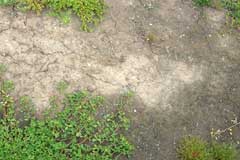 Soil crust dry just 1 hour after a rain (light areas). Grass-covered soils in the same area remained damp for days. Soil crusts tend to shed rain, rather than absorb it.
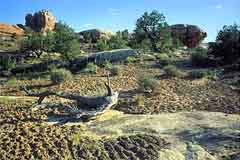 Thick biological soil crusts (ridged areas) show that this landscape in the western U.S.A. has been undisturbed by wild grazers or livestock for decades. Properly managed, this land could support grassland. Peter Donovan 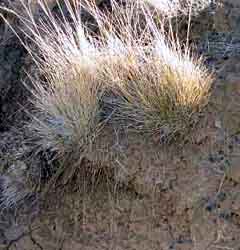 Soil crusts offer little protection against erosion. Despite "protective" soil crusts, erosion has removed all surface soil not held by plant roots. Severely eroded brittle grassland near Elgin, Oregon, U.S.A. 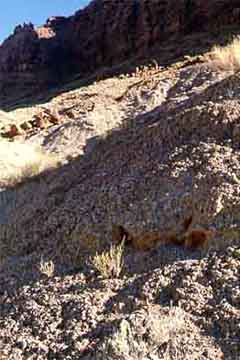 Soil crusts are natural in undisturbed brittle areas that grazing animals can't trample, such as this cliff. Where grasses cannot grow, crusts help protect soil from erosion. |
Soil crusts form on bare soil
Soil crusts (also called capping) are hard crusts that form on exposed soil in brittle and semi-brittle (seasonally dry) environments.
Soil crusts form when rain pounds bare soil, closing the water-absorbing pores on its surface and destroying its crumb structure. The soil then hardens as it dries. Soil crusts cause water to run off soil rather than soaking in, exclude air, and prevent seeds from germinating successfully.
Soil crusts that remain bare of life are called immature crusts or immature capping.
Biological crusts form when bare soil remains undisturbed
Biological soil crusts (also called algal crust, cryptogamic crust, mature soil crusts, and mature capping) are hard soil crusts dominated by a plant community of algae, lichens, or mosses. These communities can take years to form and are quite fragile.
Characteristic of long-term rest from disturbance in brittle areas, cryptogamic crusts usually indicate severe ecosystem damage that prevents succession from advancing further. On level ground, soil crusts can endure for centuries.
Biological soil crusts are poor protectors of soil
Currently touted as a solution to soil erosion on seasonally dry rangeland, biological soil crusts are not good protectors of soil because they
- Are fragile
- Take a long time to regenerate
- Lack deep roots that could hold soil
- Grow almost no food to fuel ecosystem processes or feed wildlife
- Reduce soil's ability to absorb water
- Keep soil from breathing
- Inhibit seed germination
- May prevent plant communities from advancing to more productive forms
Perennial grasses do a much better job of protecting the soil surface, and helping it absorb water. Their deep roots protect soil from erosion even after the soil surface gets exposed.
Properly managed perennial grasses can also build soil very rapidly — up to several centimeters per year.
Biological soil crusts in nature
Cryptogamic crusts are natural in undisturbed brittle areas — on cliffs and in areas where grazing animals cannot go.
Soil crusts are not natural most places they occur in seasonally dry landscapes. In these areas, nature depends on grazing animals to plant seeds, and to trample standing vegetation into mulch that protects the soil surface. Without disturbance by grazers, these areas desertify.
Where biological crusts form between grass plants, the area is almost certainly getting insufficient disturbance to maintain ecosystem health. No animals are knocking down standing vegetation into mulch that would protect the soil, or planting seeds with their hooves. Few or no young grasses can start, and bare ground will increase as old plants die. The result is desertification.
Tony & Jerrie Tipton
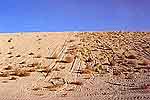 Revegetating this former gold mine required breaking the soil crust so plants could survive. 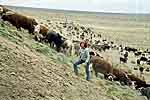 Cattle hooves broke the crust and stomped seeds and organic matter into the soil. 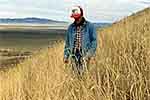 The restored land outperformed some nearby hayfields. On EcoResults! website. |
Healing environmental damage
Unfortunately, some people think soil crusts are beneficial anywhere they occur, and should be protected from disturbances such as trampling by grazers. Protecting soil crusts where they are indicators of environmental damage guarantees that succession will not advance and damaged land cannot heal.
Once trampled, crusts often become home for cheatgrass and other weedy plants. This simply means succession has started to rise. If well-managed grazing continues, these weeds soon give way to higher-succession perennial forage plants.
The proof is successfully restored landscapes. Around the world, prolonged protection from disturbance is not producing long-term gains in ecosystem health — but properly managed grazing and trampling is. Environmental restoration successes.
— Joy Livingwell
© 2005, some rights reserved
![]()
Posted 29 October 2005